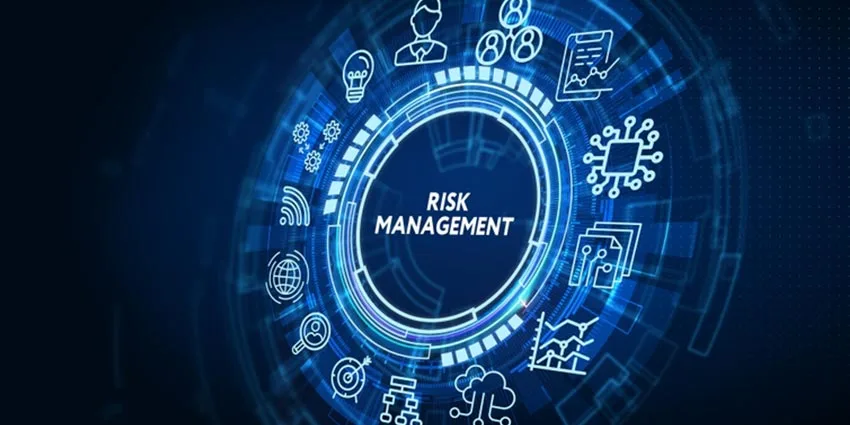GRC Roundup - October 2022 I What's New in the GRC Universe?
- GRC
- 31 October 22
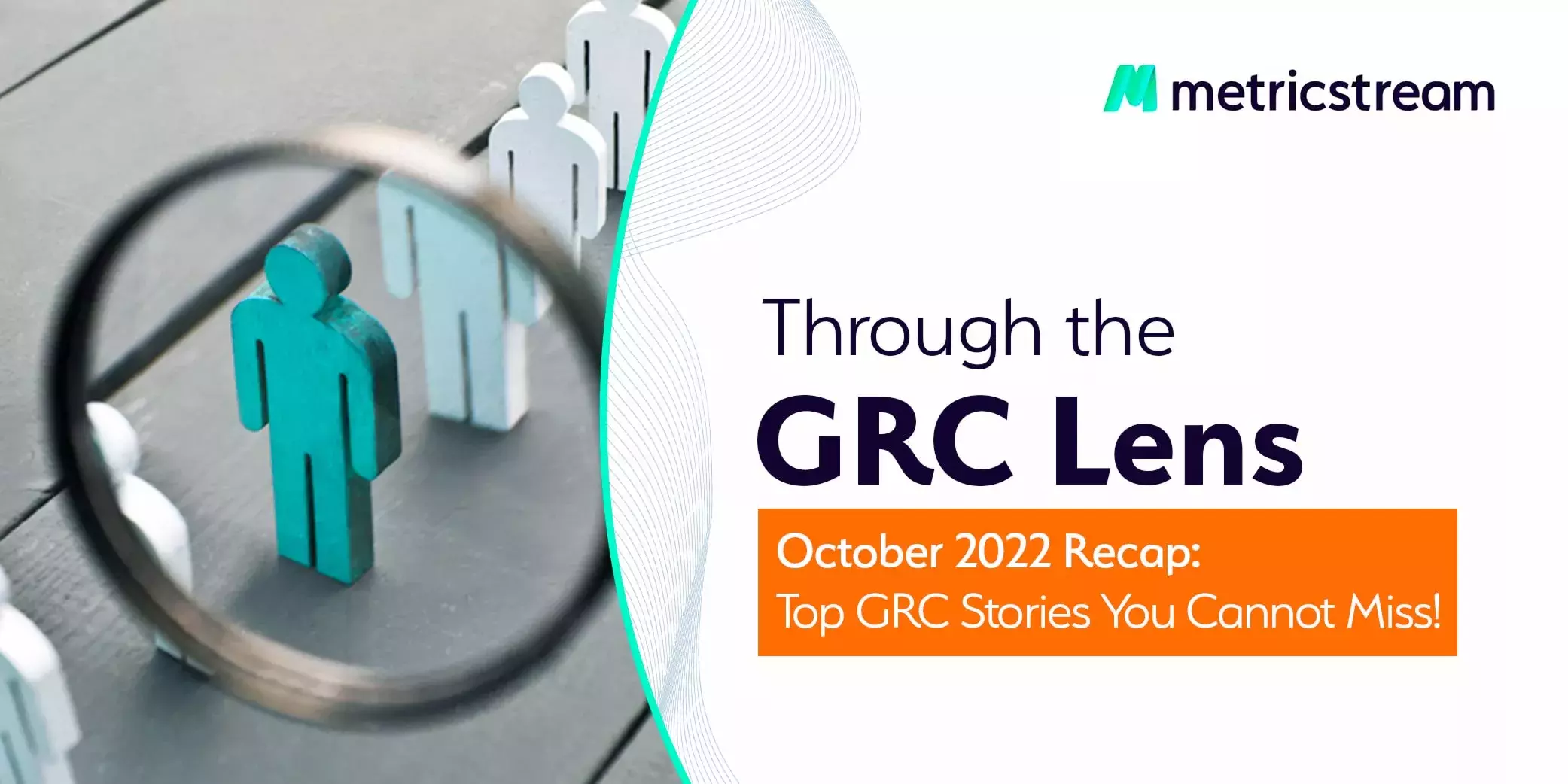
Introduction
With the constantly growing volume, pace, and complexity of risks, strengthening business continuity and organizational resilience continues to be a top concern for businesses, industry bodies, and regulators.
Speaking at the Central Bank of Nigeria’s Second National Risk Management Conference, Joshua Rosenberg, Executive Vice President and Chief Risk Officer, Federal Reserve Bank of New York, said:
“Of course, risk management should help us reduce the frequency and size of negative events and then recover more quickly and effectively when negative events occur. But, risk management, in my view, should also help the right things happen by giving us tools to work more effectively.”
October is observed as Cybersecurity Awareness Month in the U.S. This year, we saw a surge in state leaders' desire to combat cybercrime not just in the U.S., but globally. As remote work and bring-your-own-device (BYOD) becomes the norm, there is a rising awareness of unseen dangers that lie behind cloud solutions, remote work, and increasing phishing and ransomware attacks.
At the same time, regulators continue to issue ESG guidance and recommendations to help organizations drive growth with purpose. The U.S. Federal Reserve is emerging as a pioneer with its pilot program that will see six global systemically important banks running climate change scenarios, wherein they will incorporate climate change risks into their risk management frameworks.
At MetricStream, we are celebrating an important update for our growing ecosystem of customers and partners. In October, we launched Euphrates, our latest release, which includes multiple pathbreaking product and platform innovations and enhancements that help customers accelerate their GRC program performance. To learn more about Euphrates, click here.
We cover all of this and more in our monthly roundup of the latest updates and insights viewed through the GRC lens.
In the World of Risk, Regulation, and Resilience
Risks today are interconnected, requiring comprehensive solutions and a holistic approach to governance, risk, and compliance (GRC). As the risk landscape expands, developing organizational resilience through enterprise and operational risk management and keeping a close eye on critical third parties are emerging as top priorities.
The European Systemic Risk Board (ESRB) has warned about vulnerabilities in the Union Financial System, which will require private sector institutions, market participants, and relevant authorities to prepare for the materialization of tail-risk scenarios. It has identified three severe systemic risks to financial stability:
- the deterioration in the macroeconomic outlook combined with the tightening of financing conditions
- risks to financial stability arising from a sharp fall in asset prices
- the impact of the deterioration in macroeconomic prospects on asset quality and the profitability outlook of credit institutions.
Here is the top news in the areas of enterprise risk, resilience, and regulations:
- According to the 2022 Global State of Enterprise Risk Oversight, 5th edition, released jointly by the North Carolina State University, the AICPA, & CIMA, 61% of respondents from Europe and UK, 77% of respondents from Asia and Australia, 76% of respondents from Africa and Middle East, and 64% of U.S.-based respondents said that the volume and complexity of risks have increased “mostly” or “extensively,” suggesting that no specific region appears to be noticeably less risky.
- In BCI’s latest Continuity & Resilience report, 37.3% of respondents said that a board-level role for promoting and coordinating resilience efforts had been created and occupied in their organization.
- Compliance units within financial services firms are under pressure to do more with less, reports Thomson Reuters, with respondents to the recent Cost of Compliance survey saying they expect their budget to increase in 2022.
- Inflation, financial crisis, energy supply, cyber attacks, and supply chain disruptions are the top five risks identified by all business leaders responding to Aon’s 2022 Executive Risk Survey.
Getting Tough on Cyber Risks
Heads of state are urging cybercrime prevention. The White House observed Cybersecurity Awareness Month with President Biden urging people, businesses, and institutions to recognize the importance of cybersecurity and take proactive steps to protect themselves from cyber threats to support national security and resilience.
The European Commission also plans to impose strict new security rules on IT businesses that will hold them liable for the security of their goods. The Cyber Resilience Act, the first EU-wide cybersecurity regulation, will require cybersecurity safeguards for products with digital elements.
Cloud security incidents are a recurring source of concern, according to recent data from Venafi. 51 percent of the study's security decision-makers (SDMs) think that cloud-based security threats are greater than those associated with on-premise security. Ransomware attacks on SaaS data are also becoming more widespread. Gartner reported that with the increase in remote and hybrid work, the transition from virtual private networks (VPNs) to Zero Trust Network Access (ZTNA), and the shift to cloud-based delivery models, worldwide spending on security & risk management will grow 11.3% in 2023.
Here’s a quick look at the major headlines from cyberspace:
- Announcing the theme for the year as See Yourself in Cyber, the Cybersecurity and Infrastructure Security Agency (CISA) encouraged ordinary citizens to take up the fight against cybercrime.
- At the Ferma Forum, the European Union Agency for Cybersecurity stated that it is establishing cybersecurity guidelines for small and midsize firms to improve cyber risk management throughout Europe and within supply chains. EU SMEs struggling to create cybersecurity policies will benefit from the "reference" cyber standard.
- According to a recent Bank of England study, cyberattacks pose the greatest danger to the UK financial system. The rapid increase in this perceived risk can be attributed to changes in the industry that favor remote employment and cloud-based services.
- At the Gartner IT Symposium/Xpo, October 17-20, application and integration strategies, security and risk management, and infrastructure and operations were identified as the top three technology priorities for midsize enterprises (MSEs) in 2022. The top 10 strategic technology trends for 2023 highlight how investments in sustainable technology provide operational and financial benefits and can create growth opportunities to help enterprises.
- A new IBM survey reveals that more than 77 percent of cybersecurity incident responders feel a strong sense of service when reporting cyber threats. That most respondents sought mental health therapy as a result of their experiences responding to cyberattacks suggests that cyberattacks have unintended repercussions.
- Findings from the 2023 Global Digital Trust Insights by PwC indicate that cumulative investments and C-suite collaboration are among the top reasons for improvements in cybersecurity in the past year. The C-suite playbook on cybersecurity and privacy sheds more light on how CISOs and cyber teams can work together for cyber-ready futures.
- Reflecting the rapidly weaponized cyber attack landscape and escalating geopolitical uncertainty, cybersecurity tops the Risk in Focus 2023 research report which identifies the top risks facing organizations for the year ahead.
- The Deloitte/NASCIO 2022 Cybersecurity Study, "State Cybersecurity in a Heightened Risk Environment," highlighted the role of chief information security officers (CISOs) in swiftly moving government processes and services online and speeding digital transformations. It also underscored the need for state CISOs to adopt emerging technologies, collaborate with local government agencies and higher education institutions, upskill state employees, and change hiring policies to attract the next generation of highly skilled cyber professionals.
- In its Cyber Risk Trends 2022 report, Allianz said that ransomware continues to be top cyber risk for organizations. It also underscored the emerging threats posed by the growing dependencies on cloud services, the evolving third-party liability landscape, and the impact of a shortage of cyber security professionals.
ESG Regulations Taking Center Stage
Regulators are prioritizing environmental, social, and governance (ESG) issues. The importance of addressing climate risks, social equity, and environmental threats is gaining traction. As the board and executives across levels pay attention to ESG, corporate investors rely on ESG pledges and ratings to decide where to invest. Standardizing and implementing ESG reporting and ratings have become more crucial.
The Task Force on Climate-related Financial Disclosures (TCFD) reported a five-year increase in climate change awareness. Since 2017, climate change and climate-related reporting requirements have become more common in financial markets, and more companies are publicly committing to net-zero emission transition plans.
Here’s a quick recap of ESG-related news from around the world:
- In a Federal Reserve-run pilot program, six global systemically important banks (GSIBs) in the US, will be asked to run climate change scenarios. Banks will need to incorporate climate change risks into their risk management frameworks and provide full disclosures. The pilot is expected to provide insight into climate risk management and assess the resilience of institutions under different climate hypotheticals.
- The Financial Stability Board (FSB) has finalized the recommendations for standard-setting bodies to address climate-related financial risks at financial institutions in its new report, titled "Supervisory and Regulatory Approaches to Climate-Related Risks."
- Updated guidelines from the European Securities and Markets Authority (ESMA) ensure a common, uniform, and consistent implementation of the MiFID II requirements. While several guidelines remain constant, most have been updated to reflect new developments in the sustainability criteria, and take into consideration various factors, including risks and client preferences.
- The Japan Financial Services Agency released supervisory guidance on climate-related risk management and client engagement. The JFSA will present concepts and approaches for each specific theme and area in the form of discussion papers which will serve as a reference point in dialogue between the FSA and financial institutions.
- The Asset Management Association Switzerland (AMAS) has issued new ESG self-regulation that establishes a new ESG framework for Swiss collective investment scheme producers and investment managers. The new regulations will affect the release and reporting of sustainability-related data and the governance and internal operations of such collective investment schemes.
- According to a report by global law firm Dechert and global advisory StoneTurn, organizations that adopt and integrate ESG elements into their business model are more likely to create value and accelerate development while reducing legal and regulatory concerns.
Last but not least, we are gearing up to celebrate the 10th anniversary of our premier event, GRC Summit, in London on November 8-9. The two days are packed with insightful and engaging sessions on risk, resilience, compliance, cyber, and ESG, and will provide you with opportunities to network and connect with the best in the industry. Register today to become a part of the thriving GRC community. Click here.
8 Reasons Why You Should Attend the GRC Summit
- GRC
- 25 October 22

Introduction
We are well and truly in countdown mode as we approach the end of October! Not long at all now until the GRC Summit 2022 in London.
MetricStream’s flagship event, the GRC Summit, has for the past 9 years consistently provided opportunities for the GRC community to connect, share insights, exchange best practices, and most importantly set the stage for what's next in GRC. Our theme this 10th year is Experience the Power of Connection, empowering you to do more as you continue to thrive on risk!
If you haven’t got your ticket yet – here are some of the reasons you should attend the GRC Summit!
Networking
Whether it’s at happy hours, or during the breakout sessions, the Summit gives you the opportunity to mingle with your peers and industry experts over the two days. It’s been rare to have the opportunity to do this in person and now is the time to connect with old friends and make new ones!
Fun fact: With 60+ speakers and 200+ attendees there will be no lack of networking opportunities.
Education
I don’t think it’s possible to go to an event and not learn anything. No, that’s not a challenge! Come and listen to other experts discuss their GRC experiences, learn what not to do and how to make your job easier! You’ve got nothing to lose.
Fun Fact: There will be Keynote sessions on both days! Make sure you attend.
Inspiration
Be inspired to think differently! There’s nothing more gratifying than being in the presence of experts you admire as they provide insights that inspire more than just the day job. Hear from industry leaders who have come from a variety of backgrounds with a common interest in GRC and thriving on risk.
Fun Fact: Get future-ready now! Watch out for the innovation sessions on risk, resilience, and ESG.
Recognition
The GRC Journey awards offer a great opportunity to celebrate wins with your team and wider network. Each year, the awards celebrate and honor business partners, individuals, and customer organizations that have made significant strides on their GRC journeys toward strengthening business performance.
Fun Fact: Awards will be presented in 5 categories this year!
Exchange Views on Shared Challenges
Imagine being in a room with people who understand your exact situation or have been in a similar situation and can offer insights on how to solve them. Powerful right? Exchanging knowledge and best practices can help others avoid common mistakes and support their business goals. We all have regulations we need to comply with – but the process of how different organizations handle these can vary. Take time to learn from these shared challenges!
Fun Fact: Attend the Customer Case Study sessions to learn best practices.
Invest in Your Own Growth
Now while I don’t believe you need to be physically present to show personal growth, networking, and putting yourself out of your comfort zone, learning something new all goes towards strengthening your career and sharpening your skills.
Fun Fact: With 50+ sessions, the Summit is a great place to learn new skills to build your career.
Energy of Like-Minded Individuals
There’s a reason we’re talking about the ‘Power of Connection’. During COVID-19 this was non-existent, but as the world changes again we’re energized and ready to go with a stellar line-up of speakers and attendees all excited to be in London in person again!
Fun Fact: With C-level panels and expert talks, the energy is unparalleled!
Have Fun!
The GRC Summit is a conference like no other – providing you with the opportunities to learn, network, and mingle with experts and your peers! But you know what – the Happy Hour and Networking Breaks also offer you the ability to get to know other attendees and enjoy the few days we have together!
Fun Fact: From networking breakfasts to an awards dinner, you are sure to have plenty of fun-filled activities.
If you’re interested in grabbing a ticket – get in quick! You can register and find out more information here.
Check out the Agenda and Register Now!
MetricStream’s Euphrates Release. 6 Innovations to Power Your GRC Journey
- GRC
- 20 October 22

Introduction
The potential of GRC as a business growth enabler is immense. As businesses seek to build resilience in a volatile environment marked by geopolitical tensions, economic instability, health challenges, and an escalating climate crisis, a connected GRC approach that is agile, intelligent, proactive, and data-driven empowers organizations to adapt quickly and get ahead of risks. Facilitating this is your GRC software solution. Your solution should be intuitive and easily configurable, making it simple to use for risk, compliance, cyber, and ESG teams. Your solution should work for your teams to provide real-time, autonomous monitoring capabilities that can proactively capture vulnerabilities, control for limitations, and manage regulatory updates.
At MetricStream, we are committed to simplifying and streamlining how organizations manage, measure, and mitigate risk. And with the speed and scale of risk events today – and the expansion of cyber, ESG, third-party, and compliance risks – accelerating access to and delivering intuitive GRC solutions is critical to risk and resiliency management success. The innovations in our latest software release do just that—help you gain an advantage through automation, configurability, simplicity, and a connected GRC experience.
Download Now: What’s New in the Euphrates Release
Euphrates Release Innovations: Built to Empower Risk, Compliance, Cyber, and ESG Teams
MetricStream’s latest release, Euphrates, has multiple new features and functionalities to celebrate. Connected GRC insights, ease of configurability, continuous control monitoring, automated evidence management, and regulatory inventory scanning, are just a few of what’s new in this release. Scroll down to read the top 6 innovations of the Euphrates release.
Fast, Easy, and Secure Configurations with Low-Code/No-Code
Your organization is unique and so are your requirements! With the Euphrates release, it is simple for you to configure our ConnectedGRC products for your specific use cases. Low-code enables you to use GRC domain-specific language, built on the Groovy scripting language, to tailor our product to your organizational, team, or individual user’s needs—with minimal effort. No-code enables your non-tech teams to upskill and configure their own product experiences with simple drag-and-drop interfaces, enabling them to personalize applications, create and change fields, and build reports and templates. And all these configurations are automatically saved and applicable to your environment even when you upgrade to newer versions.
Connected GRC Insights in Minutes
As a future-ready organization, you know the importance of having a panoramic view of your organizational GRC posture to make informed business decisions. With the Euphrates release, data sharing between MetricStream products and third-party GRC solutions allows you to gain a comprehensive, contextual, and more accurate view of risks – within minutes, not hours, not days. And it gets better! You can configure the data-sharing capability in a few simple clicks to get a personalized report.
Faster, Easier Approach to Assessments in Operational Risk
The strategic role that the frontline plays in risk management cannot be emphasized enough. With the Euphrates release, your organization is now empowered to improve risk awareness by enabling your frontline employees with either a simple, intuitive approach or a more detailed option to complete timely, observational risk assessments. For first-line users, no prior settings are required; for second-line risk managers, demands are reduced while assessment scope and speed are increased. And by eliminating the dependency on the second and third lines, your frontline is empowered to participate more actively.
Curated Regulatory Intelligence
Keeping up with the constantly changing regulatory landscape is a continuous challenge for many organizations. With the Euphrates release, you now have exclusive access to multiple regulatory content providers, including Compliance.ai, Thomson Reuters, and CUBE. New for the Euphrates release is our extensive partnership with CUBE, the world’s most comprehensive source of regulatory intelligence, capturing regulatory content across more than 700 jurisdictions and 5,000 regulatory authorities. As integrated with MetricStream’s Regulatory Change Management, CUBE allows customers access to regulatory inventory, where regulations curated to their unique risk and regulatory profile are preloaded into the MetricStream environment. Along with horizon scanning and regulatory change alerts, customers can easily stay one step ahead of regulatory change with our content partners.
Hyper-Automate Compliance with Autonomous Control Testing on AWS
Today’s organizations are able to meet peak demands by leveraging cloud services. However, securing dynamic cloud assets and third-party products requires constant monitoring. Continuous control monitoring (CCM) capabilities, now available on AWS environments, allows your organization to automate control testing across cloud environments, initiate remedial actions, and map cloud security controls with your internal protocols and compliance standards (such as NIST CSF, PCI, ISO 27001, and HIPAA).
Streamlined Disclosure Metrics and Reporting Processes
Accurately assessing ESG risk is a vital and urgent business imperative demanded by regulators, customers, investors, and other stakeholders. However, companies need the right tools that ensure streamlined ESG disclosure metrics and reporting processes. With the Euphrates release, MetricStream’s ESGRC product includes pre-built disclosure frameworks, templates, formulas, and one-click reporting that allows organizations to convert disparate and varied emissions reporting into a single greenhouse gas metric. This metric allows for a better understanding of reporting, industry performance, and year-over-year trends. These new capabilities enhance the disclosure reporting process, provide the flexibility to configure reports, and simplify navigation and accessibility.
The Euphrates innovation brings several other innovations all with the aim to help your organization advance on its GRC maturity curve, drive business value and growth, and become future-ready.
Download Now: What’s New in the Euphrates Release
Excited to know more about how the new innovations in MetricStream’s Euphrates software release can help you on your connected GRC journey?
Request a personalized demo now.
September 2022 GRC Recap – What’s New in the GRC Universe?
- GRC
- 04 October 22
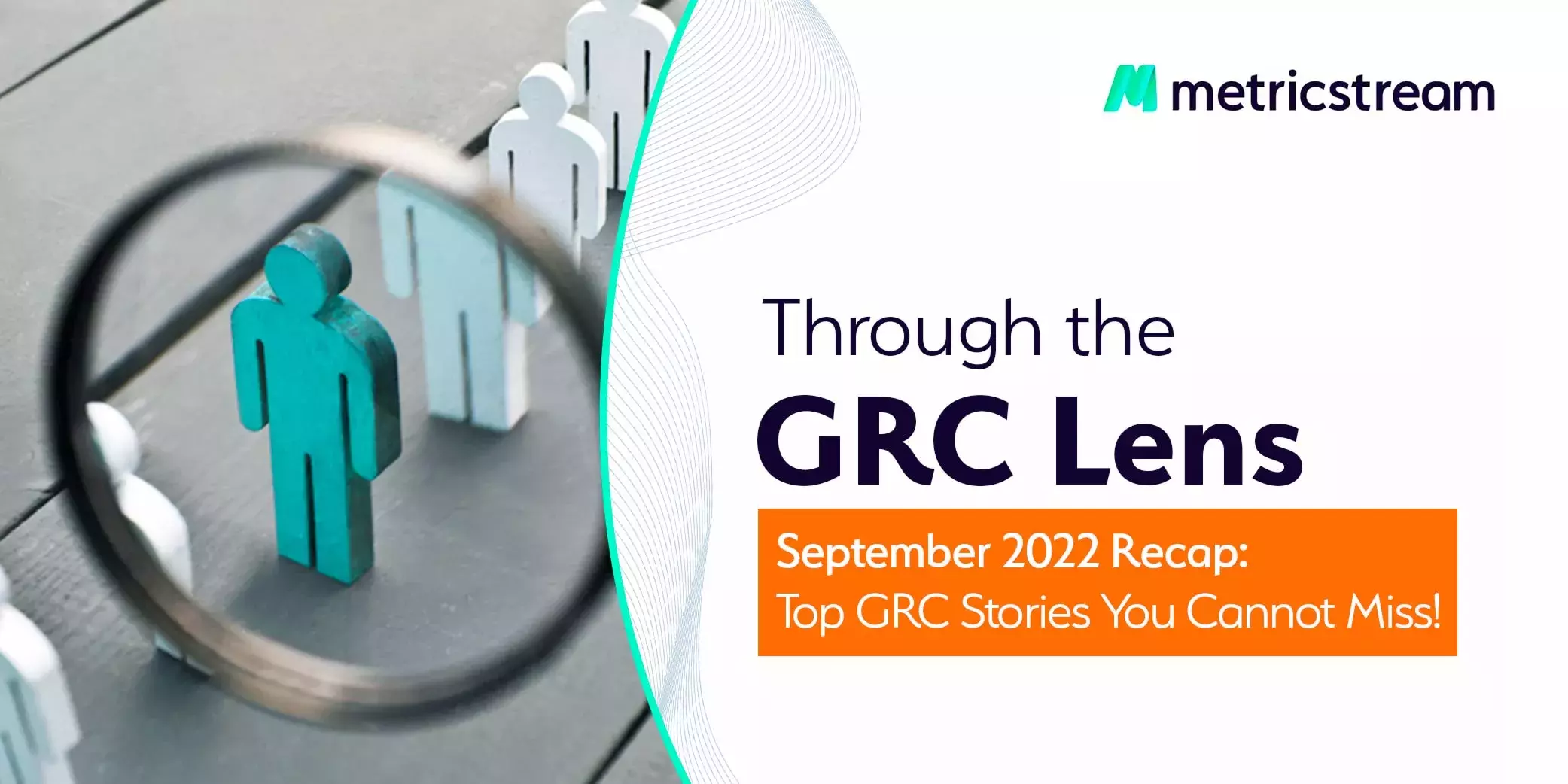
Introduction
Increased regulatory activity on operational risk management and cybersecurity. A growing focus on the ‘S’ or social in Environmental, Social, and Governance (ESG). An urgency to tackle third-party cyber risk.
The top GRC news in September 2022 boiled down to a handful of significant and common themes. And with good reason: As we enter the second half of the fiscal year, shrinking global GDP accompanied by inflation and tight labor markets, as well as evolving energy uncertainties stemming from the ongoing geopolitical crisis in Europe, has made resilience a top priority for businesses, politicians, and regulators. Other top priorities for businesses include staying focused on developing effective mitigation strategies to manage the interconnectedness of risks, especially emerging cyber, ESG, and third-party risks, and striving to build robust compliance resiliency initiatives to cope with the unprecedented levels of regulatory change.
We also want to take a moment to thank you for your continuous support. MetricStream won two industry awards—the Bronze Stevie® Award for its Environmental, Social, Governance, Risk, and Compliance (ESGRC) product and the Operational Risk Management Solution of the Year award, at the Risk.Net Asia Risk Awards 2022 for the second year in a row! You can read more about this at the end of the blog.
Several other risk and compliance stories made it to the headlines last month. Scroll down to read a curated account of the latest news in the GRC Universe from around the globe.
What’s New in Risk, Regulation, and Resilience?
- Michael Hsu, Acting Comptroller of the Currency, a major U.S. bank regulator, has warned of crisis risk from fintech proliferation. “I worry increasingly about the 'unknowns' and am concerned that the less familiar risks of this digital transition are unlabeled and thus unseen. As we learned from the 2008 financial crisis, risks that are unseen have a tendency to grow and later to be the source of nasty surprises," said Hsu.
- The Federal Reserve Board has invited comment on updates to operational risk-management requirements. This will apply to certain systemically important financial market utilities (FMUs) supervised by the Board. According to Vice Chair Lael Brainard, this initiative has been started "In light of the rapidly evolving risk landscape, (where) the proposed changes will help ensure that key financial market utilities operate with a high level of resilience and remain a source of strength for the financial system."
- The Office of the Superintendent of Financial Institutions (OSFI) an independent agency of the Government of Canada, anticipates that it will issue a final version of the Draft Guideline B-10 on Third-Party Risk Management by the end of 2022. The Draft Guideline will be more comprehensive than its predecessor, establishing enhanced expectations for Federally Regulated Financial Institutions (FRFIs) who outsource services to third parties.
- ISACA has released a new white paper, The Great Resignation: Business Challenges and Sustainable Solutions. The paper discusses key reasons for the present labor crunch and offers recommendations for establishing a sustainable, multipurpose workforce-management solution.
- The Australian Prudential Regulation Authority (APRA) has released a draft new Prudential Standard CPS 230 (Operational Risk Management). Set to replace certain existing prudential standards, the draft version with significant uplifts to governance, compliance, contractual and incident response arrangements will apply to financial institutions, superannuation funds and insurers.
What’s New in IT and Cyber Risk?
- The Cybersecurity and Infrastructure Agency (CISA) and the National Security Agency (NSA) have published a joint cybersecurity advisory about control system defense for operational technology (OT) and industrial control systems (ICSs). The advisory which provides a comprehensive understanding of the tactics, techniques, and procedures (TTPs) used by cyber criminals will help critical infrastructure owners and operators build cyber resilience.
- Part one of Securing Software Supply Chain Series - Recommended Practices for Developers, a three-part joint publication series, has been published by CISA, the National Security Agency (NSA), and the Office of the Director of National Intelligence (ODNI).
- The Government of Canada introduced Bill C-26, An Act Respecting Cyber Security in an effort to “protect Canada’s critical infrastructure” and to provide a new framework for the protection of critical cyber systems for services and systems vital to national security or public safety.
- The National Institute of Standards and Technology (NIST) has released the second draft of its Artificial Intelligence (AI) Risk Management Framework (RMF) for comment. The framework will help individuals and businesses of all sizes better understand, manage and reduce their respective “risk footprint.”
- A new EU cybersecurity rule proposed by the EU Commission will ensure more secure hardware and software products. As the first-ever EU-wide legislation of its kind, it will introduce mandatory cybersecurity requirements for products with digital elements, throughout their whole lifecycle.
- A report by SecureLink and the Ponemon Institute titled, The State of Cybersecurity and Third-Party Remote Access Risk found more than 50 percent of organizations reporting a third-party data breach in 2022 with more than 70 percent reporting that such breaches or cyberattacks in 2022 resulted from giving too much privileged access to third parties.
- Australia’s second-largest wireless carrier, Optus, suffered a major cyberattack, resulting in the personal data of up to 10 million people being compromised. While operations were not affected, the breach puts all of Optus’ mobile customers at risk, with the company expressing concern about potential phishing attacks against its customers.
- Key takeaways from the Gartner Security & Risk Management Summit 2022 London, include:
- 30% of nation-states will by 2025 pass legislation that regulates ransomware payments, fines and negotiations, up from less than 1% in 2021
- 60% of organizations will use cybersecurity risk as a primary determinant in conducting third-party transactions and business engagements by 2025
- 75% of organizations are pursuing security vendor consolidation in 2022
What’s New in ESG?
- Gaurav Kapoor, co-CEO and co-founder of MetricStream, shared key steps for leaders seeking to engage their boards for ESG initiatives.
- A commentary published by DBRS Morningstar focusing on women’s representation at the board and executive levels of European Banks found that while gender diversity was improving at board level, it was lagging behind in executive leadership roles. In a sample of 43 European Banks (2021) women represented 37% of board member seats, but only 26% on executive management teams.
- An EY survey of 300 European and UK-based fund managers found that German finance boards are the least gender-diverse in Europe. Only 29% of financial services board members in Germany are women in comparison to the European average of 37%.
- The Office of the Superintendent of Financial Institutions (OSFI), Canada, issued draft Guideline B-15: Climate Risk Management in response to the risks posed by the ever-growing threat of climate change to the Canadian financial system. The guidance will aid efforts by Federally regulated financial institutions (FRFIs) to develop resilience against such risks.
- According to Bloomberg, more than half of FTSE 100 companies now have ESG committees, with oil, gas and mining companies leading the way.
- A report by strategic communications firm Luminous, found the introduction of mandatory TCFD reporting is helping to boost awareness of climate-related risk and driving ESG integration in annual reports.
What’s New at MetricStream?
MetricStream Wins Awards for ORM and ESGRC Products
- MetricStream was crowned the winner at the Asia Risk Awards 2022 for its Operational Risk Management product for the second year in a row. The panel of judges highlighted MetricStream’s commitment to fine-tuning its product and the product’s ability to help businesses generate a deeper understanding of business risks in an increasingly interconnected risk environment.
- MetricStream was awarded the Bronze Stevie® Award for its Environmental, Social, Governance, Risk and Compliance (ESGRC) SaaS in the New Product Awards category as part of the 19th Annual International Business Awards®. The award is an industry recognition of the business value that MetricStream’s ESGRC can bring to organizations seeking to embed advanced environmental and social initiatives.
Just 42 days until the GRC Summit in London!
Now in the 10th year, the GRC Summit 2022 will feature keynotes from industry leaders, product innovation sessions, MetricStream customer success stories and practitioner-led case studies, deep-dive workshops, GRC journey awards, and more!
The GRC Summit – Where The Unthinkable Becomes The Thinkable
- GRC
- 28 September 22

Introduction
Thank you, Ma’am
The UK saw the mourning of the oldest and longest reigning monarch, Queen Elizabeth II at the age of 96, and the appointment of the 56th prime minister, Lis Truss, take place in the same week.
The queen reigned for a magnificent 7 decades and saw 15 Prime Ministers lead the country, from Winston Churchill (born 1870) to our current PM (born in 1970). It’s mind-boggling to even contemplate the historical moments that she lived through, from the Apollo II moon landing, the end of the Vietnam war, the fall of the Berlin wall, 9/11, the COVID-19 pandemic and so many more monumental events. Her majesty was the most famous person on the planet, with her face printed on more currencies than anyone else. You don’t have to be a royalist to know that she was truly remarkable. She was effortlessly resilient, always present, and in changing times constantly relevant. She would have wanted the world to celebrate her legacy and stay connected.
Let’s Shake the World and Stay Connected--GRC Summit
At MetricStream, we are continuing with the connection theme. Now in our 10th year, we will be hosting the GRC Summit in person on 8-9 November, in London. It’s bigger, better, and bolder than before. The power of connections makes you feel heard and understood. It gives you a sense of belonging. This is why the GRC Summit has been a pillar of success. It’s a chance to network with your peers, understand what’s shaping your industry, listen, and learn from veterans on what works and what needs refining. It’s where the unthinkable becomes the thinkable.
GRC leaders across industries come together to discuss, deliberate, design, test, retest, innovate and disrupt the industry.
With keynote speakers, advisory bodies, industry experts, and product demonstrations, it’s where you can get ahead of regulatory developments and thrive on risk.
How do you connect the dots of managing interconnected risks and regulations in a rapidly evolving macro landscape? How do you boost your cyber resilience? How do you increase the trust of your stakeholders with an ESG program that speaks to your customers?
The summit is where journeys, opportunities, and priorities are created.
A Stellar Line-Up of Speakers and Events to Look Forward To!
Join the 2-day event that will host 60+ sessions from 50+ speakers including renowned industry experts and thought leaders including:
- Gavin Grounds, Executive Director, Information Risk Management & Cyber Security Strategy, Meta
- Grace Beason, Director of Governance, Risk and Compliance, Guidewire
- Renisha Rajpaul, Executive Head: Business Risk Management (Project - Head of ERM), Vodacom
- Jumsheed Hussain, Executive Director Credit & Risk Management, Qatar Development Bank (QDB)
- Paola Corna Pellegrini, President of AICEO-Associazione Italiana, CEO, President of Winning Women Institute, Vice-President of the Meritocracy Forum
- Joe Martinez, Chief Security Officer, AON
- Adrian Furniss, Head of Risk, Lloyds Banking Group
- Neil Sinclair, Programme Lead, Police Crime Prevention Initiatives
Also watch out for other speakers from Goldman Sachs, Barclays, JP Morgan, AON, Almarai, and many more.
And don’t miss out on the top highlights which include:
- Keynotes from Industry Leaders
- Innovation Sessions
- Customer Success Stories
- GRC Journey Awards
We look forward to welcoming you to our GRC summit this November. Let’s keep the connection alive and shake the world.
Thrive on Risk by Harnessing the Power of the GRC Community
- GRC
- 14 September 22

Introduction
Here in the UK during the last few months, we’ve seen a flurry of events announced. Whether in person or virtually, people are truly wanting to maximize interactions and learn from their peers. At MetricStream, we have been at the forefront when it comes to providing a platform for professionals to connect and help facilitate conversations. This enables discussion around various problems their organization is facing, concerns they have, and subjects they’d like to discuss further.
We’ve recently hosted a few peer-to-peer events and heard from attendees about their take on current industry happenings. Now we’re approaching our next event! This one is slightly larger than a peer-to-peer event but the excitement doesn’t wane. For the past 9 years, our flagship event, the GRC Summit has consistently provided opportunities for the GRC community to connect, share insights, exchange best practices, and most importantly—look to what's next in GRC. As we enter our 10th year, our commitment to building connections remains strong.
Bringing the Industry Together
While MetricStream may host these events, our primary goal is to connect industry practitioners. These events offer the mechanism to form a community of experts, learn from their specific circumstances, develop their professional network, share trends, inspire others and discuss all things GRC.
Of course, there are other benefits to us being a part of such events. GRC events offer a forum where we can have interactive, candid, and engaging conversations with our customers, prospects, and others from the GRC community to understand their pain points, requirements, and thoughts on key trends. It helps us stay close to key market trends and needs. These insights provide us with validated information which in turn helps us improve our products and solutions.
The GRC System is Only as Good as the Data Input
The foundation of GRC is the data—the data that you track, the controls that are managed, and the reporting of adherence to these controls. The processes become incredibly difficult when they are not in a format that talks to each other and are easy to update.
Some of the conversations that we’ve had point to the importance of not only having the proper systems in place but also that these systems are only as useful as the data in them. At a recent peer-to-peer event, we had one attendee mention how important it was to ensure that “when you accurately update your data, that it automatically updates the relevant systems” and “having too many manual Excel documents creates issues with maintenance and updating”. Another attendee mentioned how “If you haven’t got everything being entered in the same way, it can completely skew the results”. Right data, right time, and right use are integral to a GRC system. Quality data forms a foundational step with GRC activities before you even look for a solution. You cannot make a process better if you cannot track the success and metrics around it.
Collaboration is a Huge Differentiator
While technology has always been seen as an enabler, participants confirmed the importance of both ‘culture and education’. The education piece is hugely important in organizations alongside driving a risk-aware culture from the top. It’s also important to remember that educating staff on how to adhere to certain policies and their relevant confines ensures they are better prepared to tackle issues that may arise and deal with them in a compliant manner.
Another attendee brought up the important discussion point that “we’re all human beings but how do we share the knowledge”. Sharing of knowledge sounds easy but without a safe forum to discuss these important topics, our lessons learned don’t get shared. Collaboration for the greater good can be a huge differentiator. Take things you learn, share what you’ve learned – and keep the ball rolling.
What GRC Industry Events Enable:
- Place to talk about industry happenings and make sense of things collectively
- Time to discuss implementation with peers and the errors where businesses listened too much to users and over-customized software
- Discussions around the importance of finding the right balance between business needs and best practices
- Ability to gain new ideas because people may know things you don’t
- Take recommendations from peers that may help improve processes in ways beyond what you originally thought possible
There is no doubt that we all have been on a journey together supporting each other as the GRC landscape gets more intense and has emerged as a critical business imperative. At MetricStream, we believe in the power of the GRC community and the power of connection. Our events are designed to help you move beyond just managing risk to embracing it, and ultimately thriving on risk. It's a catalyst to implementing solutions that work for the entire organization, from the risk office to the front line, delivering a connected, single source of truth to business leaders.
Have You Registered for the 2022 GRC Summit in London?
MetricStream’s flagship event, the GRC Summit, will be held in person on the 8th and 9th of November 2022, at the Royal Garden Hotel, London. As we celebrate our 10th year, we have chosen our GRC Summit theme to be Experience the Power of Connection. Join the 2-day event that will host 60+ sessions from 50+ speakers.
Top highlights include:
- Keynotes from Industry Leaders
- Innovation Sessions
- Customer Success Stories
- Deep Dive Workshops
- GRC Journey Awards
Come, meet us at the GRC Summit in London! Register Now.
GRC Roundup - August 2022 I What's New in the GRC Universe?
- GRC
- 01 September 22

Introduction
This year has been extremely challenging for businesses around the world. The already inundated governance, risk, and compliance (GRC) teams at organizations are further stretched thin as they try to keep up with the rapidly evolving business, cyber and ESG risks, the ever-evolving regulatory landscape, and escalating geopolitical crises.
Our recent survey with OCEG confirmed how challenged organizations are with GRC today. A large number of organizations are still relying on distributed, segmented, and separate systems for managing GRC. A meager 7% of respondents said they have “excellent” GRC capabilities today.
[For a quick look at the key takeaways of the OCEG GRC Readiness for Rapid Change Survey 2022, click here. To download the complete survey report, click here.]
What are the top concerns of businesses and regulators today? Is GRC still an afterthought? What are the new cyber challenges for companies in this new normal? Are companies going to walk the talk on ESG? Let’s find out what made it to the headlines in August – through the GRC lens.
What’s New in Risk, Regulation, and Resilience
Operational risk and resilience continue to be priority areas for regulators.
The Australian Prudential Regulation Authority (APRA) has started consulting on a new prudential standard that aims to bolster the management of operational risk in the banking, insurance, and superannuation industries. The Monetary Authority of Singapore (MAS) published a paper that sets out its expectations, good practices, and improvement areas for operational risk management at financial institutions based on its inspections of selected banks over 2020 and 2021.
In another update, Germany’s financial market regulator BaFin levied a $5.28 million fine on a leading US-based financial institution for delays in reporting voting rights notifications.
Several survey and research reports published last month underscore the importance of risk and compliance management at banks and corporations alike:
- Fitch Ratings found regulatory fines to be the overriding theme in news reports centered on corporate-governance failings by banks worldwide. “We believe this reflects both the prevalence of regulatory fines and the media’s propensity to report on bank fines, often headlining the amounts,” Fitch Ratings observed.
- Based on its recent survey, Gartner said that the most important factor in reporting of misconduct by employees is whether they think it will work well for them. The IT research firm called upon compliance leaders to understand what drives employees to report misconduct.
- According to FERMA’s 2022 European Risk Manager Survey, resilience has never been higher on the top management’s agenda. For risk managers, risk mapping, which is described as the firm's way to identify and document their important business services, continues to be one of the most important activities. However, there is a growing focus on developing specific risk assessment exercises. “This highlights a trend to continue assessing organisations’ resilience in a context of transition towards more sustainability in a digital world,” the report said.
What’s New in Cyber
A cohort of leading cybersecurity and technology organizations, including AWS, Splunk, IBM Security, and others, have come together for an open-source effort, called the Open Cybersecurity Schema Framework (OCSF) project, to break down data silos that hamper security teams. The project aims to help organizations detect, investigate, and stop cyberattacks more quickly and effectively.
The Australian Council of Financial Regulators released a revised version of the Cyber Operational Resilience Intelligence-led Exercises framework (CORIE framework v2.0). The CORIE framework aims to support the preparation and execution of industry-wide financial sector cyber resilience exercises.
Here’s a look at the current state of cyber risk and compliance management based on recent reports:
- The global average cost of a data breach reached an all-time high of $4.35 million in 2022, marking a 2.6% increase from the year before, according to the IBM-Ponemon Institute’s Cost of a Data Breach Report 2022.
- According to ENISA Threat Landscape for Ransomware Attacks, around 10 terabytes of data were stolen each month by ransomware threat actors between May 2021 and June 2022. About 58% of the stolen data included the personal data of employees.
- In a mid-year update to its 2022 SonicWall Cyber Threat Report, SonicWall said that there has been an 11% rise in global malware, a 77% increase in IoT malware, and a whopping 132% spike in encrypted threats.
- VMware’s eighth annual Global Incident Response Threat Report identified application programming interface (API) as the new endpoint with 23% of the attacks now compromising API security. The report touted APIs as the next frontier for cyber attackers.
- In the PwC’s second Pulse Survey of 2022, cyber risk emerged as the top business risk – 40% of respondents categorized frequent and/or broader cyber attacks as a serious risk.
- In the Cloud Security Alliance and Proofpoint study, 58% of survey respondents said that third parties and suppliers were the target of a cloud-based breach in 2021.
- According to the 2022 Honeywell Industrial Cybersecurity USB Threat Report, the number of threats designed specifically to target industrial control systems increased slightly to 32% compared to 30% in the previous year.
What’s New in ESG
Regulatory focus on environmental, social, and governance (ESG) aspects continues to gather steam. A joint committee of European Supervisory Authorities, namely the European Banking Authority (EBA), the European Insurance and Occupational Pensions Authority (EIOPA), and the European Securities and Markets Authority (ESMA) published the first annual report on the extent of voluntary disclosure of principal adverse impact under the Sustainable Finance Disclosure Regulation (SFDR).
It lays out a preliminary, indicative, and non-exhaustive overview of best practices and voluntary disclosures. In another update, ESMA called for a “quality label” to prevent investors from being misled by greenwashing.
In Singapore, a new initiative has been launched to set a uniform baseline for banks to engage their corporate clients on environmental risk issues. The Association of Banks in Singapore (ABS) rolled out the ABS Environmental Risk Questionnaire (ERQ), which will enable banks’ customers to collect data points and identify opportunities for financing the transition to a low-carbon economy.
In Australia, the Financial Services Council (FSC) published its guidance on Climate Risk Disclosure in Investment Management. It details a set of common baseline expectations for net-zero commitments for the investment management industry, disclosure of climate-friendly investment features, and reporting of climate change risk.
Here’s a look at the current state of ESG risk management based on recent reports:
- To offset the impact of rising inflation, talent shortages, and supply constraints, the first areas where organizations will cut investments are mergers and acquisitions (M&A) and sustainability, according to a recent study from Gartner.
- In a recent survey conducted by Cognizant, 90% of respondents recognized attention to ESG issues as an essential aspect of being a modern business. However, only 35% of respondents said that they are currently incorporating ESG into company strategy.
What’s New @ MetricStream
We are gearing up to celebrate the 10th anniversary of our premier GRC event in London on November 8-9. The GRC Summit 2022 will feature keynotes from industry leaders, product innovation sessions, MetricStream customer success stories and practitioner-led case studies, deep-dive workshops, GRC journey awards, and more! To check out the complete agenda, click here.
MetricStream-OCEG Survey Reveals Growing Need for Connected GRC Programs
- GRC
- 10 August 22
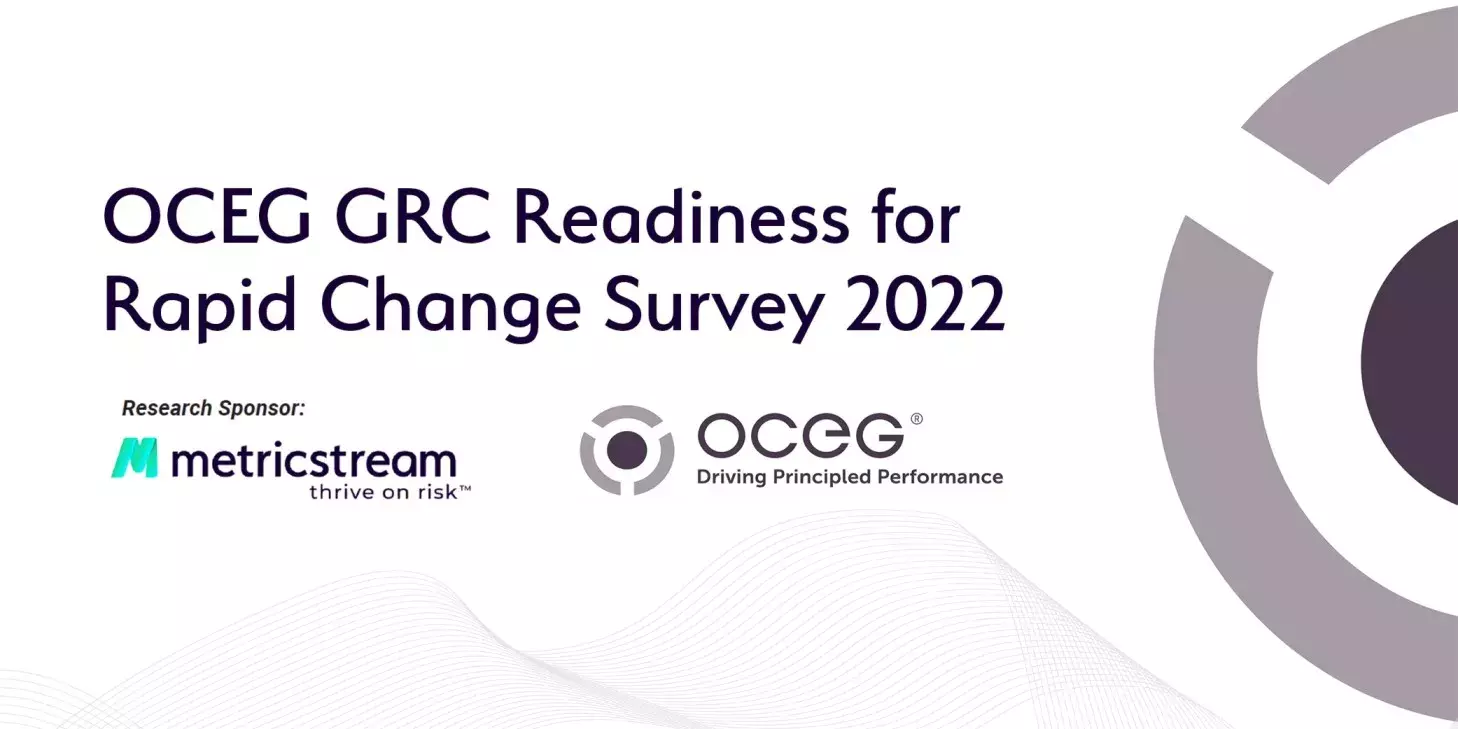
Introduction
As someone who has been working in the GRC market for more than six years, it’s always interesting to tap into the trends and moods of the market and its buyers. In a former role, I built and ran annual market surveys on GRC systems, capabilities, needs, and evolving top concerns of risk and compliance professionals. This year, MetricStream collaborated with OCEG on an especially timely and topic-rich survey of GRC professionals. The outcomes are surprising, not surprising, and I believe, a strong reflection of the state of the market, all at the same time.
The survey, conducted in February 2022, was focused on GRC program readiness in a highly unpredictable and dynamic time for risk and compliance. Nearly 350 GRC professionals representing a cross-section of roles, industries, geographies, and company sizes completed a broad survey, resulting in a published report.
Download the Report: OCEG GRC Readiness for Rapid Change Survey 2022
The results show a handful of key findings and one trend that bears some analysis. Here’s a quick snapshot of a small handful of findings with data:
1. Too many organizations do not have a fully defined and documented GRC strategy. At a time when the pace and severity of risks and compliance challenges are increasing and intensifying, an organizational strategy that enables a holistic approach to managing, mitigating, and gaining advantage from risks from across the business is essential.
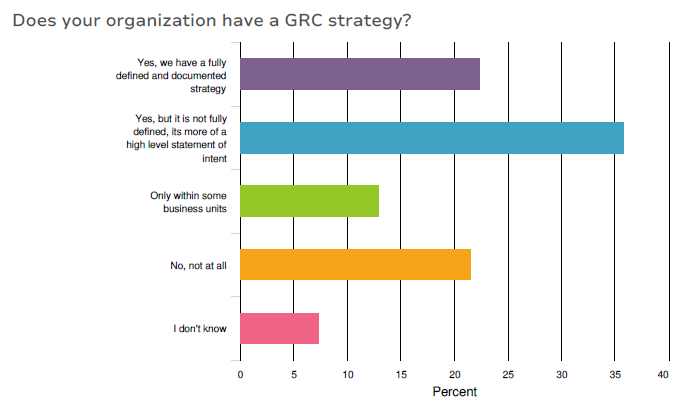
2. Too many GRC approaches rely on distributed, segmented, and separate systems. While virtually all GRC pundits and experts talk about the importance and urgency of investing in improved visibility, insight, and actionability across connected GRC systems, we still see that many are still using separate, unlinked systems and approaches, and far too many are using software not designed to support GRC functionality.
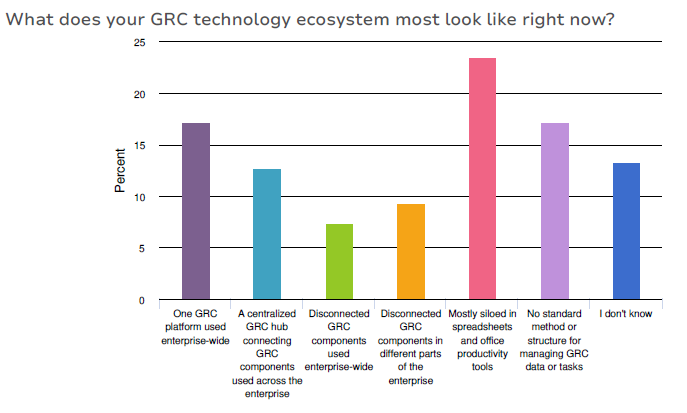
Similarly, we also see that many respondents are still struggling with siloed programs, even while the pressure to perform increases. There is palpable recognition among respondents of the limitations of segmented systems and the vulnerabilities they create. 34% of respondents reported that siloed risk and compliance management was their greatest barrier to rapidly responding to changes in risks.
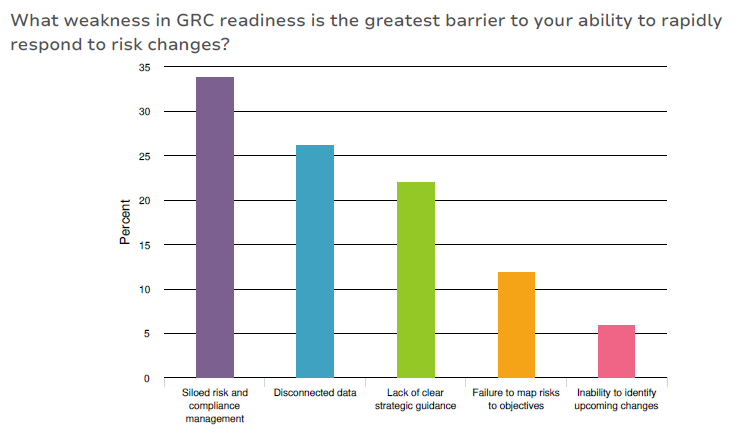
While that chart might indicate a market without clear direction and priorities, we found that many respondents are clear on what they need to address many of their challenges. And given the pace, scale, and severity of risks these days – across economic and financial risk, regulatory compliance, cybersecurity risks, third party risks, audit risks – it’s good to see that so many identify integrated processes, technologies, controls and data as so central to addressing their challenges.
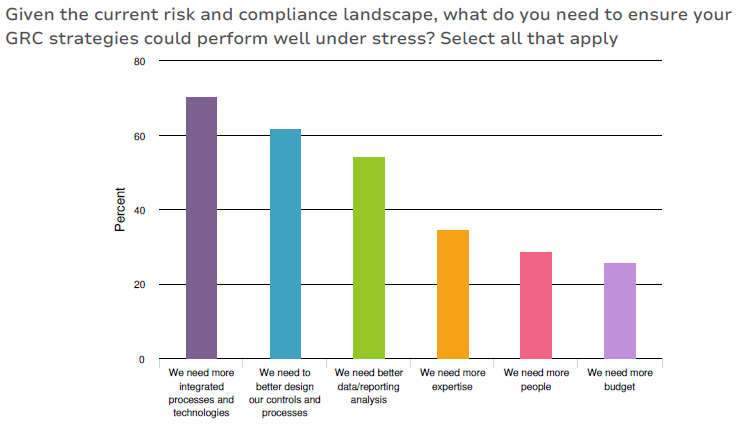
3. Not surprisingly, given the data above, only 7% of respondents said they have excellent GRC capabilities today. And 47% report that their programs are good. This is, ironically, an improvement over the last few years. Yet there are still improvements to make, and most seem to recognize it.
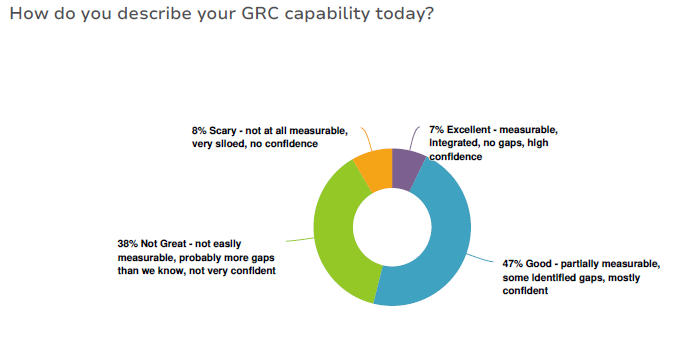
While those points tend to show progression on data that analysts have been collecting for years about the state of the GRC marketplace, the most interesting findings to me relate to how people perceive heightened challenges from the last few years, and how their GRC programs have had to adapt to them.
This survey showed that nearly 85% of respondents report significant changes in their GRC universe in the last two years, with nearly 70% reporting increasing challenges related to employees working remotely, and 60% reporting increased data privacy and cybersecurity concerns. At the same time, nearly 20% of respondents have not acted or can’t report any changes in their programs in response to broadly acknowledged increases in risk.
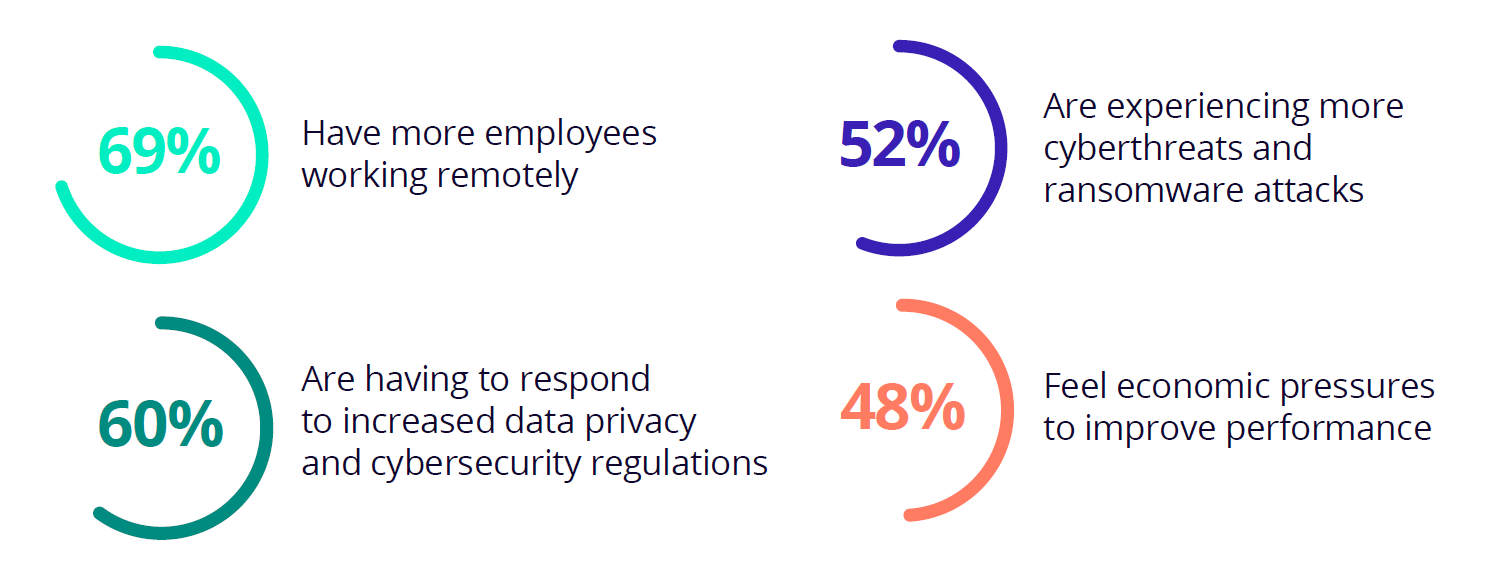
In terms of adapting to these rapid changes in the risk and compliance environment, 61% of respondents indicate their organizations place maturing cyber security and data protections as very important in the next 24 months, 56% indicate maturing regulatory compliance as very important, 54% operational risk and business continuity strategies as very important, and just over 50% indicate audit and financial controls as very important. In fact, there were no elements of a complete GRC program, including managing third-party risk and ESG risks, that did not score under 50% ranking it very important. Sadly, that’s not surprising, given the risk and compliance environment today.
The recent significant changes in the risk environment and a recognition of a need to adapt GRC programs for risk-readiness and organizational resiliency is central to how those with GRC oversight should be viewing their programs. The days of periodic risk assessments and separate risk and compliance functional teams are over. Any business that wants to be able to rapidly adapt to risks, regulatory changes, and cybersecurity best practices must strive to unify their systems, data, policies, controls, and actions in a connected solution to best enable holistic understanding, management, and advantage.
In an increasingly dynamic and unstable world, isolating risk signals in the noise, linking and aggregating data and enabling real-time insight can make the difference between organizations suffering from unexpected risks and being able to anticipate and gain an advantage from them. We are at a very interesting and consequential point in GRC maturity. GRC is a business-critical function with strategic significance for how businesses operate and succeed. Segmented and separated systems create strategic disadvantage where connected systems help deliver readiness, resiliency, and advantage.
Read the full report: Download OCEG GRC Readiness for Rapid Change Survey 2022.
Check out how MetricStream can help you implement a connected GRC strategy. Explore ConnectedGRC. Request a demo now.









